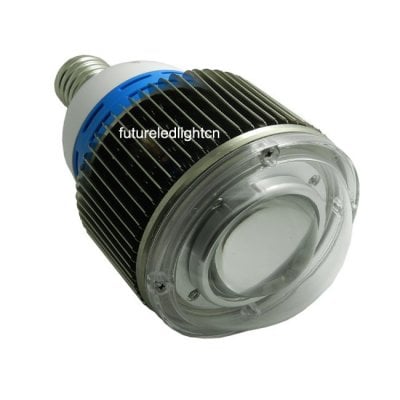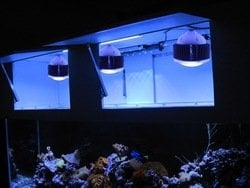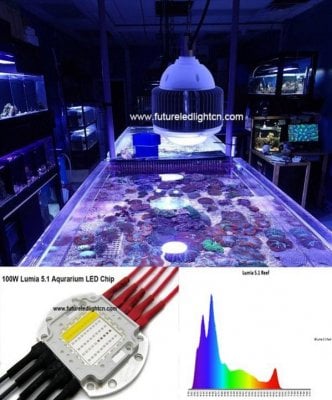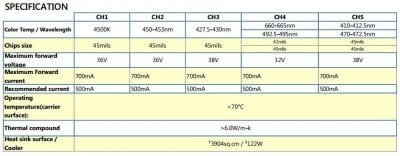Hey guys - I finally was able to fix my Lumia chip that I killed on day one. I accidentally pulled out the lead going into the NW channel. Milad assures me that this is not the norm, but I will still caution everyone to be careful with those leads! Luckily, I was able to melt part of the plastic bits to get to where the wire leads, uh, lead  . Soldered the wire back on, and I was in business!
. Soldered the wire back on, and I was in business!
Right off the bat... this thing is wicked bright. I was not paying attention to where I was looking when I removed the jumper to my LDD powering the NW string, and it blasted my eyes - and I still see spots. So don't look directly into them :lol:
The product page for the Lumia can be found here. The cost is right around $100 for the chip. The Lumia has five channels, each with ten LED diodes epoxied onto the base and ran in series, for a total forward voltage of 32-38v per channel, so yes, this will require five separate drivers to power, unless you have high-voltage drivers.
The channels are as such:

The chip is pretty straightforward. Comes with wire leads preattached for each channel, so plug them in and you're ready to go.
There are no optics for the chip as of yet, so you will not find readings or pictures including any. Once Milad sends me one, I will update this thread with new pictures and PAR readings.
The board that the LEDs are attached to is tin-plated copper, which has very good thermal transfer. Clive Bentley (a true LED guru) has a bit more information on the LEDs themselves, and cautions that the maximum LED junction temperature is 70°C for the deep red chips, which is much lower than that of the others, but because of its inclusion, the entire chip is limited to that temperature. To add to it, the LEDs on this chip are not soldered into place, but epoxied, which does limit thermal transfer. I believe that the copper PCB should make up for that, though, and the use of a properly sized and actively cooled heatsink will keep it well under that temperature. blasterman reports that properly cooled LEDs rarely exceed 40°C if I'm not mistaken.
I'm running the chip on a 6" MakersLED heatsink with the provided fan, and after running for nearly an hour at full bore (700mA, 126 watts), the heatsink was not warm to the touch, and the LEDs had not lost intensity (as when LEDs get hot, they emit less light). With that being said - I always recommend overkill. If I were using this over one of my tanks, I would use a 12" Makers (or any other heatsink with similar cooling capacity) and not one, but two fans - in case one dies, there will be a backup to keep the heatsink cool, which could definitely save your LEDs - well worth the bit of extra money, as the fans will fail long before the LEDs do (I've found an average lifespan of three years on 'computer' fans). Redundancy is your friend.
First off, some pics of the unit itself, and my professional soldering station.




Here you can see where I melted the casing to reattach the wire.

Installation was pretty straightforward since I'm using a Makers heatsink. Four screws, run wire to each lead, plug in. Mine was a bit more complex because of the LDD and the boards, but if I wasn't just throwing this together, it would look a lot nicer. All LDD used are 700mA (the maximum you can run the Lumia, and will pull 126 watts of power) on the 250w 48v power supply from LEDGroupBuy.
Got it lit up and took some pics. All pictures were taken with a Canon Rebel T1i, 1/125 shutter, f2.8 aperture, ISO 800, and white balance set to 'white fluorescent light (4000K)' as this seems to give consistent results. Photos were imported into Lightroom (taken as RAW) and were not messed with, except for the first set on the table where I needed to lower the exposure so it didn't look like one color filling the frame
Neutral white channel


Royal blue channel


Hyper violet channel


Turquoise (cyan) and deep red channel


True violet and cool blue channel


All channels


Told ya it was bright.
Continued in the next post.
Right off the bat... this thing is wicked bright. I was not paying attention to where I was looking when I removed the jumper to my LDD powering the NW string, and it blasted my eyes - and I still see spots. So don't look directly into them :lol:
The product page for the Lumia can be found here. The cost is right around $100 for the chip. The Lumia has five channels, each with ten LED diodes epoxied onto the base and ran in series, for a total forward voltage of 32-38v per channel, so yes, this will require five separate drivers to power, unless you have high-voltage drivers.
The channels are as such:
- 10x 4500K neutral white (36v)
- 10x 450nm royal blue (36v)
- 10x 430nm hyper violet (38v)
- 5x 495nm turquoise (cyan) and 5x 660nm deep red (32v)
- 5x 405nm true violet and 5x 470nm cool blue (38v)

The chip is pretty straightforward. Comes with wire leads preattached for each channel, so plug them in and you're ready to go.
There are no optics for the chip as of yet, so you will not find readings or pictures including any. Once Milad sends me one, I will update this thread with new pictures and PAR readings.
The board that the LEDs are attached to is tin-plated copper, which has very good thermal transfer. Clive Bentley (a true LED guru) has a bit more information on the LEDs themselves, and cautions that the maximum LED junction temperature is 70°C for the deep red chips, which is much lower than that of the others, but because of its inclusion, the entire chip is limited to that temperature. To add to it, the LEDs on this chip are not soldered into place, but epoxied, which does limit thermal transfer. I believe that the copper PCB should make up for that, though, and the use of a properly sized and actively cooled heatsink will keep it well under that temperature. blasterman reports that properly cooled LEDs rarely exceed 40°C if I'm not mistaken.
I'm running the chip on a 6" MakersLED heatsink with the provided fan, and after running for nearly an hour at full bore (700mA, 126 watts), the heatsink was not warm to the touch, and the LEDs had not lost intensity (as when LEDs get hot, they emit less light). With that being said - I always recommend overkill. If I were using this over one of my tanks, I would use a 12" Makers (or any other heatsink with similar cooling capacity) and not one, but two fans - in case one dies, there will be a backup to keep the heatsink cool, which could definitely save your LEDs - well worth the bit of extra money, as the fans will fail long before the LEDs do (I've found an average lifespan of three years on 'computer' fans). Redundancy is your friend.
First off, some pics of the unit itself, and my professional soldering station.




Here you can see where I melted the casing to reattach the wire.

Installation was pretty straightforward since I'm using a Makers heatsink. Four screws, run wire to each lead, plug in. Mine was a bit more complex because of the LDD and the boards, but if I wasn't just throwing this together, it would look a lot nicer. All LDD used are 700mA (the maximum you can run the Lumia, and will pull 126 watts of power) on the 250w 48v power supply from LEDGroupBuy.
Got it lit up and took some pics. All pictures were taken with a Canon Rebel T1i, 1/125 shutter, f2.8 aperture, ISO 800, and white balance set to 'white fluorescent light (4000K)' as this seems to give consistent results. Photos were imported into Lightroom (taken as RAW) and were not messed with, except for the first set on the table where I needed to lower the exposure so it didn't look like one color filling the frame
Neutral white channel


Royal blue channel


Hyper violet channel


Turquoise (cyan) and deep red channel


True violet and cool blue channel


All channels


Told ya it was bright.
Continued in the next post.
Last edited:





































